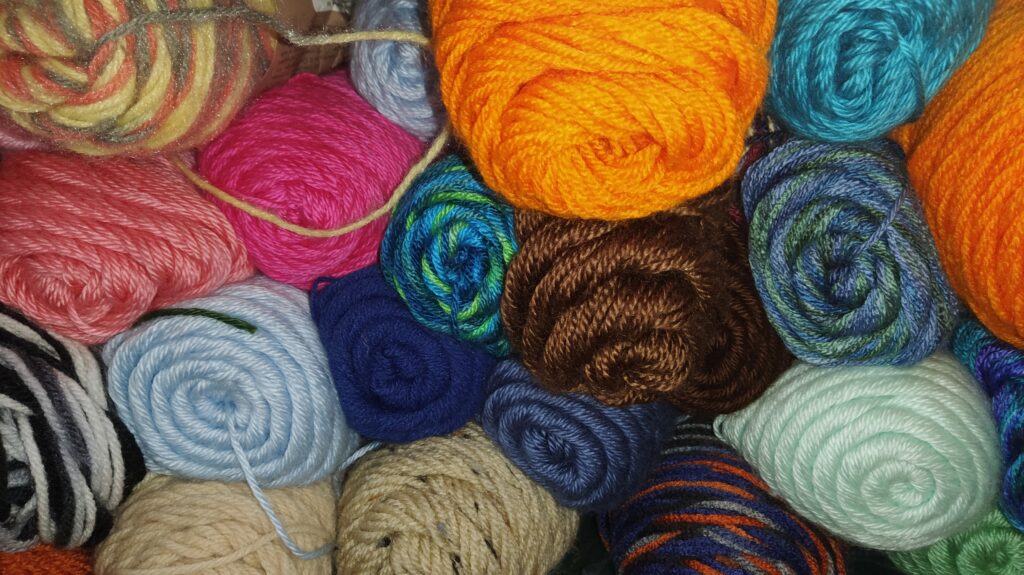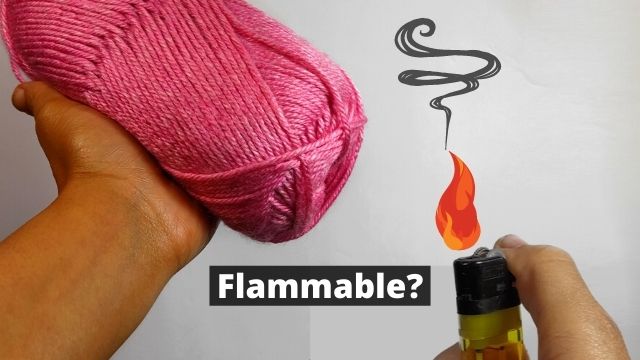Yes, acrylic yarn is flammable. Acrylic is made from Acrylonitrile, a colorless flammable liquid that is derived from polypropylene plastic. Once ignited, the fabric melts. This leaves a plastic sticky substance that can cause extremely severe burns. Never use acrylic yarn on heat-resistant projects like potholders.
What is acrylic yarn?
Acrylic is the “workhorse” yarn for crocheters, knitters, and crafters. This is considered the “cheap yarn” by many crafters. Acrylics tend to be much more affordable than their natural fiber yarns.
You can purchase acrylic yarns at most hobby stores. You’ll find a huge selection in all big box craft stores such as Joanns. Acrylic yarn is also widely available online. Due to the vast production of these yarns, they offer a wide variety of colors, which is important to many knitters and crocheters.

Acrylic is a synthetic man-made fabric that was originally developed to be an alternative to wool. Today it’s a widely popular fabric for its durability and ease of care. It’s a synthetic material with a wide range of possible uses. Acrylic can be made into yarn or fabric as well as many other types of products.
Acrylic fibers are very durable, making them excellent for any project that needs a sturdier yarn. As a petroleum-based product, it will take many many years for it to degrade.
What is acrylic made of?
Acrylic is made from Acrylonitrile, a colorless flammable liquid that is derived from polypropylene plastic. It is combined with other chemicals and placed into a spinning solution. The mixture is then either injected into an air-filled space and dry spun or sprayed into the water and wet spun. The fibers are then washed, dried, and crimped. At this stage, the fibers are either long and continuous “tow” fibers or they are short “staple” fibers like wool or cotton. Both types of acrylic fiber can be woven into a fabric, resulting in a different look.
Why does acrylic burn?
All fabrics will burn, but some are more combustible than others. Acrylic is the most flammable of all synthetic fibers. It can be difficult to ignite, but once acrylic catches fire, it burns vigorously. Acrylic fibers melt and drip. This means that if acrylic yarn catches fire, it may cause deep burns.
Despite this danger, it’s considered fire-resistant, because it resists ignition at much higher temperatures than natural fibers. Acrylic fabrics treated with flame retardants contain toxic compounds necessary to slow the development of ignition and increase their ability to withstand high temperatures.
Tightly weaved fabrics will burn more slowly than loosely weaved, light fabrics of the same material. Crochet & knit naturally create a looser stitch than machine-made fabrics. Some of the acrylic yarns have a long, loose, fluffy texture that can ignite more readily than fabrics with a hard, tight surface, and in some cases will result in flames flashing across the fabric surface.
Choose acrylic projects carefully
Acrylic yarn is flammable. This means that acrylic yarn won’t be a great choice for your potholder projects or other projects that involve fire or intense heat. It can also shed small fibers of plastic material when washed, which enter into the water supply and can damage the environment.
Yarns made of acrylic fiber aren’t environmentally friendly or healthy. Their manufacturing has both health and environmental impacts. The process of manufacturing acrylonitrile, the main chemical in acrylic yarns, has a significant carbon footprint. The petroleum products used in manufacturing are not sustainable, and the product itself may be carcinogenic.
The burn test
Acrylic is made from natural gas and petroleum. When ignited the yarn flares up and shrinks from the flame. It then begins to burn rapidly with hot sputtering flames, and drip dangerously. The drips turn into little hard plastic beads that are dark with irregular shaping. The melting process continues after the flame is removed and is self-extinguishing. While burning, the yarn gave off a strong acrid, fishy odor. Although no ash is left, their black smoke and hazardous fumes in the air.
Since acrylic is a synthetic fiber, it doesn’t leave ash. It’s basically plastic, you will be left with a hardened plastic substance. This is what can melt and burn your skin. This hot, sticky, melted substance causes localized and extremely severe burns.
Advantages
- Affordable: Since acrylic yarn is man-made, it can be easily mass produced. This brings down the cost of yarn considerably.
- Durable: The durability of acrylic yarns makes the perfect for all crochet patterns that require tough enduring yarn.
- Easy to Clean
- Wide Color Selection: Natural yarns don’t take color as well as acrylic yarns. Causing the colors to be off. Acrylic allows for more consistent coloring allowing for a wider selection of colors.
- Hypoallergenic: This is great for those who have a sensitivity to natural fibers such as wool. Very few people are allergic to acrylic yarn.
Disadvantages
- Flammable: This yarn is flammable and will melt
- Texture: Acrylic yarns lacks the softness of natural fibers
- Environmental: Most man-made substances typically are bad for the environment. Acrylic yarn is plastic which means that it will take decades to completely break down
Conclusion
Should you get rid of all your acrylic yarn? Acrylic yarn is the go to for many crocheters due to its availability, price and variety of colors. But you should be aware that the potential damages the fibers you use. Acrylic yarn is very flammable and can cause burns from its melted material. Never use it on heat related crochet projects.
If you enjoyed this informative article about acrylic yarn, then you may want to find out if an acrylic yarn is good for the summer?


